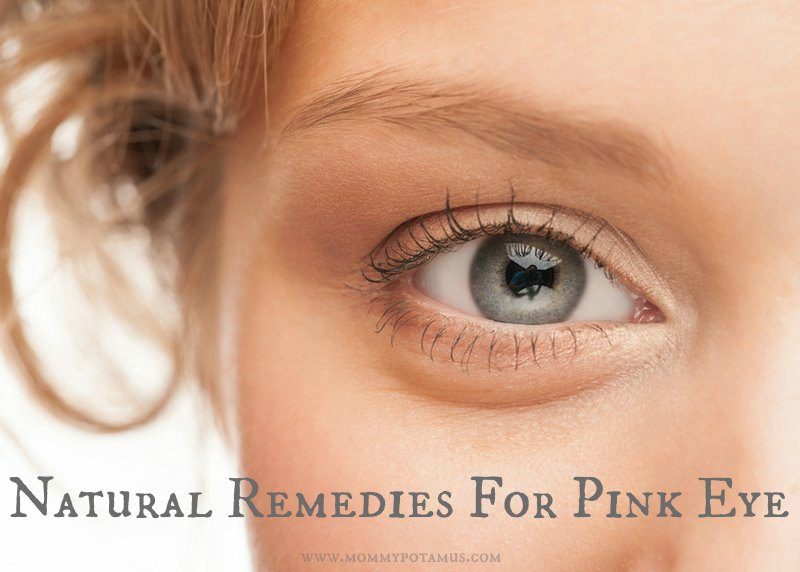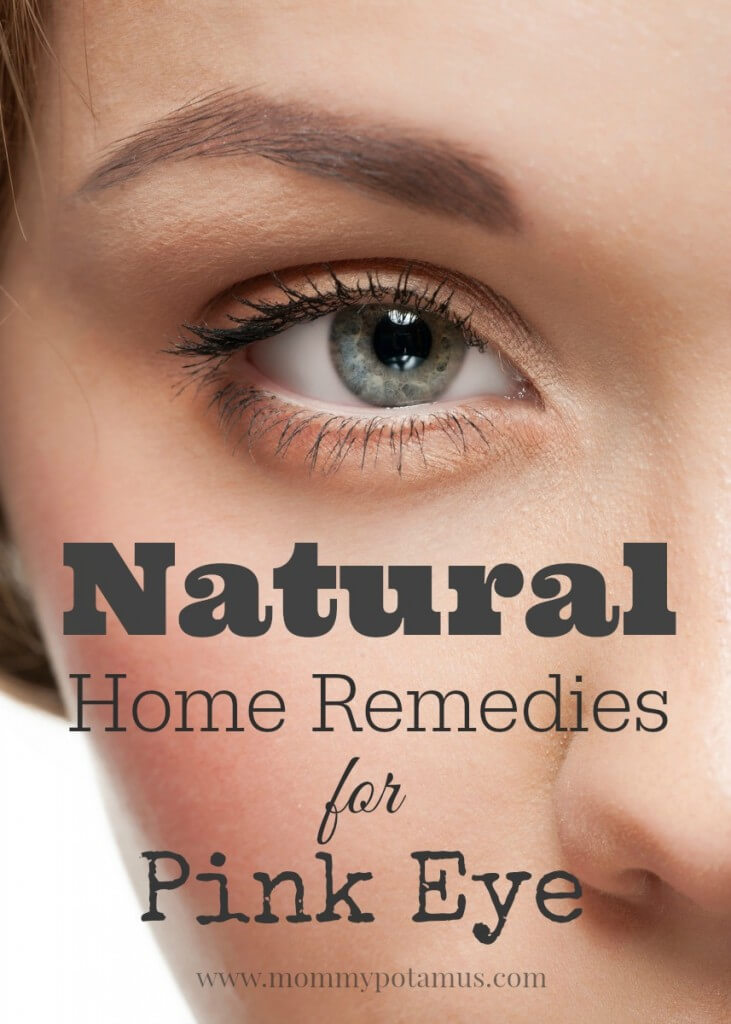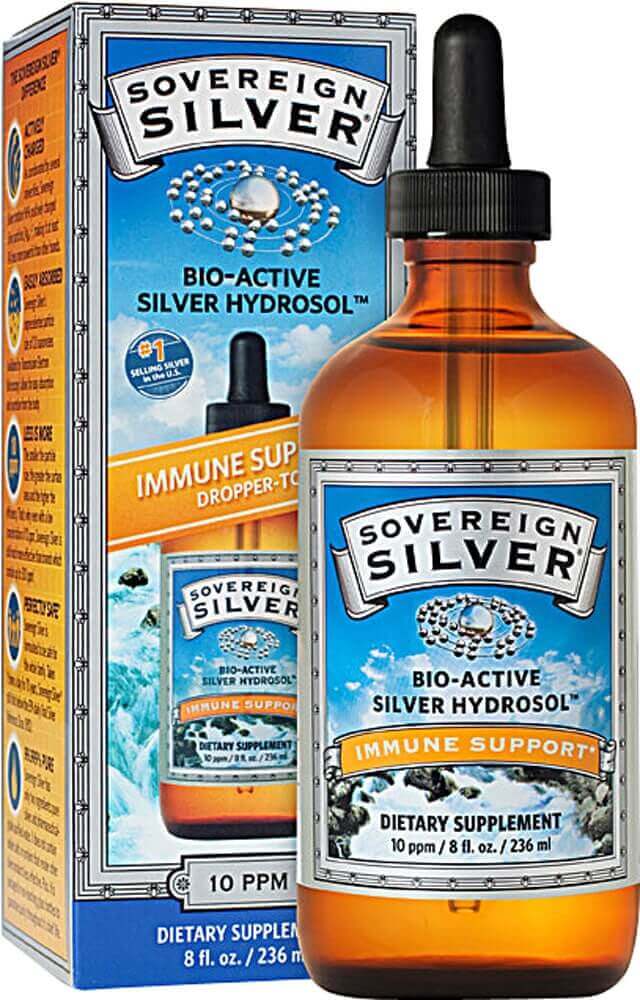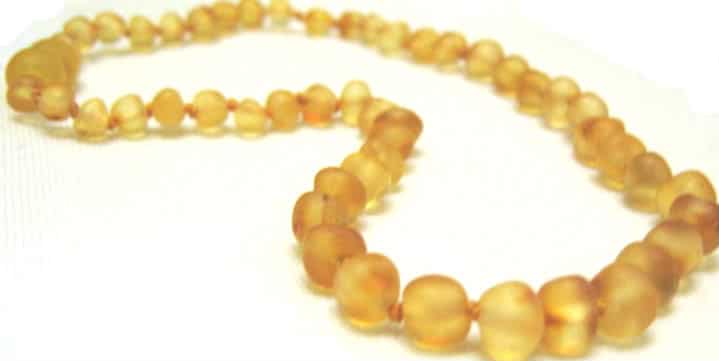
There are three reasons to love pink eye:
1. It’s a nice break from giving the stink eye. Gotta mix things up, you know?
2. You can use it to repel awkward interactions – “Don’t come near, I’m CONTAGIOUS!”
3. Sorry, that’s all I’ve got. Who actually loves pink eye???
Fortunately, there are several natural remedies for pink eye out there that mamas swear by. Today I’m going to share them with you, along with studies I’ve found related to each remedy. But first, let’s ask one very important question . . .
What Causes Pink Eye? ^
Like ear infections, most cases of pinkeye are viral in nature. However, some are bacterial and others are actually an allergic response.
Viral Pink Eye Is…
- Typically marked by clear, watery drainage
- Contagious
- Likely to start in one eye and move to the other
- Not treatable with antibiotics. “Most viral pinkeye cases have no specific treatment – you just have to let the virus run its course, which is usually four to seven days” (1)
- Often somewhat alleviated by some of the comfort measures listed below. Immune system support may also be helpful.
- Often difficult to discern from bacterial pink eye (2)(3)
Bacterial Pink Eye Is . . .
- Typically marked by greenish yellow drainage
- Contagious
- Likely to start in one eye and move to the other
- Usually treated with antibiotic eye drops. Some who prefer to avoid antibiotics use some of the natural approaches below.
- Often difficult to discern from viral pink eye (2)(3)
Allergic Pink Eye is . . .
- “Allergic pinkeye (caused by seasonal pollens, animal dander, cosmetics, and perfumes) and chemical pinkeye (from chemicals or liquids, including bleach and furniture polish) are not contagious.” (1)
- Clear, watery drainage is typical
- Usually involves both eyes
“Allergic pinkeye symptoms should improve once the allergen source is removed and the allergy is treated. Chemical pinkeye requires prompt washing of the affected eye(s) for five minutes and an immediate call to the doctor.” (1) Treatments for the allergy may include an antihistamine. Nettle capsules or tea are considered by many to be a natural antihistamine, and preliminary studies suggest that this may indeed be the case. (4)
Of course, these descriptions are general in nature and may not apply in all situations. We’ll get to some natural remedies for pinkeye in just a sec, but first please keep in mind that “Best Boo-Boo Kisser South Of Puckett’s Gas Station” is about as official as things get for me professionally. I am not a doctor, this is not medical advice, these statements have not been evaluated by the FDA and are not meant to diagnose, treat, or cure any disease, and your medical decisions are completely up to you. If you need some convincing on this, read my full disclaimer where I say it over and over again. Okay, moving on!

Natural Remedies For Pink Eye ^
Because pink eye can be highly contagious, it is usually recommended that individuals address both eyes even if only one has irritation.
Honey
Frank Dougan of Glasgow spent eight years searching for relief from blepharitis, a chronic bacterial infection of the eyelid. ‘Lots of doctors gave me eyes [sic] drops, I have a whole fridge full and I have spent a fortune but nothing worked,’ he told the UK-based Daily Mail. (5)
So what did finally work? According to Frank, it was a jar of honey from the local Tesco. His optician confirmed that she was no longer able to find any traces of blepharitis.
Countless studies have affirmed honey’s beneficial properties. In fact, according to a Cochrane analysis of 19 clinical trials, this pantry staple may work better than antibiotic creams for burns. (6) Here’s how I use it in my first aid kit.
So what do we know about its effectiveness with pink eye? I am not aware of any studies that have directly looked at this issue, however, there are a few studies that have explored the use of honey for various eye irritations. Here’s what they concluded:
Studies that may support the use of honey for some kinds of eye irritation
In one study, the application of honey significantly reduced the number of bacteria found on and around the eye in patients that suffer from dry eyes. (7)
Another analysis notes that honey is being ” ‘rediscovered’ by the medical profession, particularly where conventional modern therapeutic agents have failed. Recently published reports describe the effectiveness of honey in rapidly clearing wound infection with minimal adverse effects, and also possible in promoting healing with minimal scar formation. Honey also has antimicrobial action against a broad spectrum of bacteria and fungi, both in laboratory studies and in humans. Its use in the eye ranges from treating post-herpetic corneal opacities, local conjunctival lesions and corneal edema with variable results.” (8, emphasis mine)
Also, though it is not a study, “there is evidence that the ancient Egyptians used honey to treat eye diseases, the Greek philosopher Aristotle is credited with being among the first to record medicinal use of honey for the eyes as far back as 350 B.C. Honey was also widely used in India to treat eye disease and has been used by traditional healers in Mali to prevent scarring of the cornea in cases of measles. There is also evidence that honey was used by the medieval English to treat eye diseases.” (9) (10)
What kind of honey is best?
The exact type of honey used in the studies mentioned above was not specified. However, in the world of natural remedies I know manuka honey is often sought because it contains high levels of the compound dihydroxyacetone. However, I didn’t have any on hand when I woke up with pink, irritated eyes last year so I used this instead.
How I use it:
Ingredients:
- 1/4 teaspoon raw honey
- 1/4 cup distilled or reverse osmosis water (or water that has been boiled for 5 minutes and allowed to cool)
- pinch of sea salt (optional – this is what I use)
Instructions:
Dissolve raw honey and optional salt in pure warm water. Don’t get the water too hot or it may alter some of the beneficial properties of the honey. Using a clean dropper, place a 1-2 drops in each eye every few hours as needed.
Breast Milk
According to one article, a “particular antibody in the breast milk, called immunoglobulin A, prevents the pink eye bacteria from attaching to the mucosal surface of the eye. This limits the growth of the bacteria, helping to end the eye infection.” (11)
So what does the clinical data say? Although there are no studies that address pink eye directly, this article examines three studies that look at the impact of colostrum on newborn eye infections. The antimicrobial properties of colostrum and breast milk are well-documented and there does seem to be some evidence of benefit for use with eye infections, but at least one of the studies where the evidence seems overwhelmingly positive was not well constructed.
On the other hand, moms swear by it.
Bonus awesome breast milk fact: A few years ago researchers noticed that cancerous lung cells in a test tube died on contact with breast milk, so they isolated the key compound responsible and began injecting it into tumors. So far, trials with rats have shown that “after just seven weeks a highly invasive brain cancer called glioblastoma was seven times smaller in those treated with HAMLET [the nickname for the breast milk compound].” (12)
How to use it
Using a clean spoon, place a few drops onto the surface of the eye. “Lift your eyelid slightly to help the breast milk circulate underneath. Continue this treatment three times a day for a couple of days, or until the eye infection has cleared. If your symptoms persist or worsen, though, seek medical advice.” (13)
Colloidal Silver
The use of silver solutions for eye infections is nothing new. Until the creation of erythromycin, an antibiotic ointment, silver nitrate drops were routinely used in newborn’s eyes to prevent certain types of bacterial infection. In some hospitals, they are still used, but most doctors prefer the ointment because silver nitrate can cause irritation. (Please note that in mentioning its routine use in newborns is not an endorsement. I recommend that you research before consenting to it or any other newborn procedure.)
Silver nitrate is created by combining silver with nitric acid, while colloidal silver contains only silver particles suspended in water. It is my understanding that colloidal silver is generally considered less irritating.
What have doctors said about it? Not much it seems, however, I did find a few comments from M.D.’s who said simply that their patients swear by it and that it might be worth trying. (13) (14)
According to Ray Sahelian, M.D., “I have come across several people who swear that colloidal silver — when used as eye drops 1-2 drops 3 to 4 times a day– quickly healed their conjunctivitis or sty, or reduced the severity of pharyngitis when gargled in water. Perhaps colloidal silver is effective against viruses and some bacteria. So, considering all factors, if I were to make a decision, I would say colloidal silver is worth a try for a few days in cases of conjunctivitis or sty or perhaps other mild infections, but it should not be used for longer than one week at a time. Its use should be done under medical supervision by a health care provider who is familiar with its properties. I, personally, have not used it with patients.”
Wondering if colloidal silver is safe? I like Emily Bartlett, LAc’s take on it.
How to use it
As referenced by Dr. Ray Sahelian, M.D. in the quote above, those who rave about this remedy typically say they use 1-2 drops of 5-10 ppm (that’s the concentration) colloidal silver in each eye three to four times per day.

Herbal Tea Poultices
According to Prescription For Nutritional Healing, “Calendula, chamomile, fennel and/or eyebright teas can be used to make hot compresses. Eyebright can also be taken orally in capsule or tea form. It is good for any eye irritation or inflammation. The tea can also be used to rinse the eyes.”
Caution: Do not use chamomile or calendula if you are allergic to ragweed. Some sources, such as Prescription For Nutritional Healing, say not to use during pregnancy or nursing. (p. 421) However, many herbalists and OB-GYN’s say chamomile is perfectly fine during pregnancy and while nursing. (15)
Some individuals add a pinch of salt to their tea as it brews to boost the astringent quality of the poultice.
How to use it
According to some sources, distilled water is recommended because any impurities in water could exacerbate the infection. You can find instructions for making chamomile and calendula eye soothers at Mother Earth News.
In Prescription for Natural Cures: A Self-Care Guide For Treating Health Problems With Natural Remedies, which was also written James F. Balch, M.D., along with Mark Stengler N.M.D, and Robin Young Balch, N.M.D, eyebright is mentioned again with a little more clarification. It is recommended for both pink eye and irritation due to allergies. In the section on allergies, it is suggested that readers “apply as a solution to irritated eyes by adding 3-5 drops of eyebright tincture to an ounce of contact lens (saline) solution in a disposable cup. Rinse each eye with separate cups and toss the cups after use. Do this once or twice a day to relieve irritated eyes and remove redness.”

Salt Water Wash
According to Chris A Knobbe, M.D., irrigating the eye’s surface with a sterile salt water (saline) solution several times daily may give additional relief. (16)
Some eye drops contain lubricants and other medications for various conditions, but there are options out there that just contain salt and sterilized water.
Wondering if it’s possible to make your own saline solution? Just like with the teas, using water that has not been boiled or sterilized in some way is not recommended. However, according to Chemistry expert Anne Marie Helmenstine, PhD, it is possible to make – she explains how here.
Comfort Measures ^
Warm Or Cold Compress
“To reduce pain and to remove the discharge of bacterial or viral pinkeye, use a cold or warm compress on the eyes. Make sure to use a different washcloth for each eye to prevent spreading any infection. And use clean washcloths each time. Clean the eye from drainage by wiping from the inside to the outside of the eye area.” (17)
Raw Potatoes
Fresh slices of cold, raw potato are also said to be soothing.
Pink Eye Prevention ^
Recurring pink eye infections may be associated with vitamins A and B (especially B2) deficiencies, so it may be worth exploring supplementation if infections continue to occur. (18) (19)
Cod liver oil is a source of naturally occurring vitamin A. You can find the brand I buy on my shopping page under Superfoods & Supplements.
When To See A Doctor ^
According to the CDC, “Most cases of pink eye are mild and get better without treatment. However, some forms are more severe. Severe cases need to be looked at by a health care provider and may require specific treatment and close follow-up. If you have pink eye, you should see your health care provider if you have—
- Moderate to severe pain in your eye(s)
- Blurred vision or increased sensitivity to light
- Intense redness in the eye(s)
- A weakened immune system, for example, from HIV or cancer treatment
- Bacterial pink eye that does not improve after 24 hours of antibiotic use
- Symptoms that get worse or don’t improve
- Pre-existing eye conditions that may put you at risk for complications or severe infection”
The CDC also recommends that all babies with pink eye symptoms be seen by a health care provider (exact wording: “immediately”).
Looking for More Remedies? ^
You may find these helpful:
- Natural remedies for ear infections
- Home remedies for tummy aches (plus my five question stomach ache checklist)
- Natural remedies for lice
Do you have a favorite natural remedy for pink eye? Please share it below!
This article was medically reviewed by Dr. Sheila Kilbane, MD, a board-certified pediatrician, trained in integrative medicine. As always, this is not personal medical advice and we recommend that you talk with your doctor.
Disclaimer: I am not a doctor and I don’t play one here on this site. These remedies are shared for educational purposes only and are not meant to diagnose or cure any disease. None of these statements have been evaluated by the FDA and are not meant to diagnose, treat or cure any disease. See my full disclaimer here.
Sources for this post:
- Pinkeye (Conjunctivitis): Causes, Symptoms, & Treatments
- The Mayo Clinic: Pinkeye Basics
- All About Vision: Conjunctivitis
- Penn State Medical Center
- Daily Mail: Man Cures Painful Eye Infection With Jar of Honey
- UK National Health Service
- Effect of antibacterial honey on the ocular flora in tear deficiency and meibomian gland disease
- Traditional Medicine in Oman: Its Role in Ophthalmology
- Is Pinkeye Contagious? Manuka Honey
- The antibacterial activity of honey and its role in treating diseases
- The Healing Power Of Breastmilk
- Daily Mail: Is breast milk the new wonder cure?
- Ray Sahelian, M.D.: Colloidal Silver
- The Survival Doctor: Pinkeye Remedies
- Christopher Hobbs, LaC., Mary Lake Polan, M.D.
- Chris A Knobb, M.D.
- Web MD
- Vitamin A and carotene concentration in serum in persons with chronic conjunctivitis and pterygium
- Conjunctivitis and Riboflavin Deficiency
Want more research-backed natural remedies?
No problem, I’ve created a free ebook for you – Kitchen Apothecary: 25+ Natural Remedies Using Ingredients From Your Pantry – as a gift for signing up for my newsletter. You’ll also get updates when I post about safe essential oils for pregnant/breastfeeding mamas, exclusive gifts and coupons (I was able to give away a jar of free coconut oil to anyone who wanted it recently!), plus other goodies.
Sign up using the form below.





